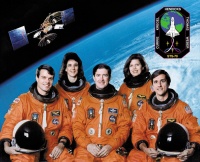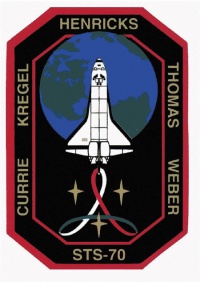STS-70
From The Space Library
 | |
| Organization | NASA-Office of Space Flight (United States) |
|---|---|
| Mission type | Human Crew |
| Launch date | July 13, 1995 |
| Launch vehicle | Space Shuttle |
| Launch site | Cape Canaveral, United States |
| COSPAR ID | 1995-035A |
| Inclination | 28.45 degrees |
| Experiments | Here |
| Alternate Names | 23612 |
| Additional Information | Here |
| Data Collection | Here |
| Payload Mass Up | 20159 kg |
| Payload Mass Down | 3032.27 kg |
| Orbiter | Discovery |
| Lift Off Mass | 2,055,350.91 kg |
| Orbiter Weight at Liftoff | 117,538.18 kg |
| Orbiter Weight at Landing | 88,595.91 kg |
| Landed | Concrete runway 33 at Kennedy Space Center, Fla. |
| Orbits of Earth | 142 |
| Orbital Altitude | 160 nautical miles (184 statute miles) |
Contents |
[edit] Crew
- Commander: Terrence T. Henricks
- Pilot: Kevin R. Kregel
- Payload Commander:
- Mission Specialist 1: Nancy J. Currie
- Mission Specialist 2: Donald A. Thomas
- Mission Specialist 3: Mary Ellen Weber
- Mission Specialist 4:
- Mission Specialist 5:
- Payload Specialist 1:
- Payload Specialist 2:
ISS/Mir Crew Transport
[edit] Mission
STS 70 was launched from Cape Canaveral into a 160 mile circular orbit above the Earth. On board was a five person crew consisting of Commander Tom Hendricks, Pilot Kevin Kregel and Mission Specialists Donald Thomas, Nancy Currie and Mary Ellen Weber. STS 70's prime objective was to deploy the Tracking and Data Relay Satellite-G (TDRS-G), the last in the series of a space-based satellite network that provided communications, tracking, telemetry, data acquisition and command services essential to Shuttle and low-Earth orbital spacecraft missions. About 6 hours after launch, it was released from Discovery's payload bay and boosted into a geostationary orbit. The TDRS system is a space-based network that provides communications, tracking, telemetry, data acquisition and command services essential to the Space Shuttle and other low-Earth orbital spacecraft such as the Hubble Space Telescope (HST), the Compton Gamma Ray Observatory (GRO), the Upper Atmosphere Research Satellite (UARS), Cosmic Background Explorer (COBE), Extreme Ultraviolet Explorer (EUVE), TOPEX-Poseidon, Landsat and many more. TDRS-G will reside in geosynchronous orbit at 22,300 miles (35,888 kilometers) at 178 degrees West longitude. It was built by TRW and weighs about 4,900 pounds. The deploy operations utilize 3 separate control centers to manage orbit operations. The White Sands ground station will control the TDRS, the JSC Mission Control Center (MCC) will control the shuttle, and the Inertial Upper Stage (IUS) control center at Onizuka Air Force Base in Sunnyvale California will control the boster stage. Deploy operations will begin six hours into the mission. Once deployed, the TDRS satellite has a wingspan of 57 ft. TDRS-G will add to the complement of satellites already in orbit. Secondary objectives of the mission were to fulfill the requirements of the Physiological and Anatomical Rodent Experiment / National Institutes of Health-Rodents (PARE/NIH-R); Bioreactor Demonstration System (BDS), Commercial Protein Crystal Growth (CPCG); Space Tissue Loss/National Institutes of Health-Cells (STL/NIH-C); Biological Research in Canisters (BRIC); Shuttle Amateur Radio Experiment-II (SAREX-II), Visual Function Tester-4 (VFT-4); Hand-Held, Earth Oriented, Real-Time, Cooperative, User-Friendly, Location-Targeting and Environmental System (HERCULES); Microcapsules in Space-B (MIS-B); Windows Experiment (WINDEX); Radiation Monitoring Equipment-III (RME-III); and the Military Applications of Ship Tracks (MAST). STS-70 marked the maiden flight of the new Block 1 orbiter main engine. Engine number 2036 features the new high-pressure liquid oxygen turbopump, a two-duct powerhead, baffleless main injector, single-coil heat exchanger and start sequence modifications. The modifications are designed to improve both engine performance and safety. The Block I engine will fly in the number one position on Discovery. The other two engines are of the existing Phase II design.
[edit] EVA
[edit] Payload
Tracking and Data Relay Satellite (TDRS) G/ Inertial Upper Stage (IUS); Bioreactor Demonstration System (BDS) B; Biological Research in Canisters (BRIC); Commercial Protein Crystal Growth (CPCG); Hand-Held, Earth-Oriented, Real-Time, Cooperative, User-Friendly, Location-Targeting and Environmental System (HERCULES); Microcapsules in Space (MIS) B; Physiological and Anatomical Rodent Experiment (PARE)/National Institutes of Health (NIH) Rodents (R); Radiation Monitoring Experiment (RME) III; Shuttle Amateur Radio Experiment (SAREX) II; Space Tissue Loss (STL)/National Institutes of Health (NIH) Cells (C); Military Applications of Ship Tracks (MAST); Visual Function Tester (VFT) 4; Window Experiment (WINDEX)
[edit] Books about the Space Shuttle Program
Buy This Book Click here |
Buy This Book here |
Buy This Book Click here |
Buy This Book Click here |





